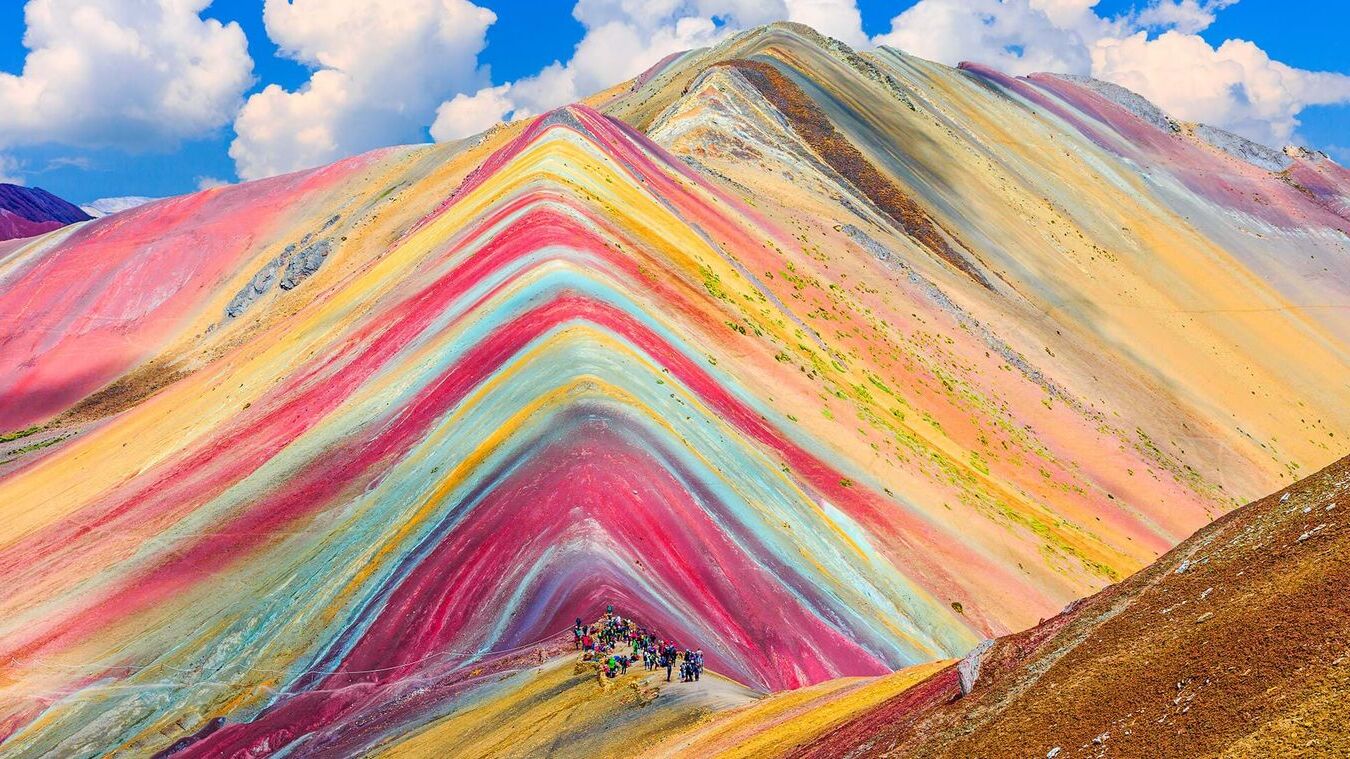
Vinicunca, also known as the Rainbow Mountain, is a stunning natural wonder located in the Peruvian Andes. This vibrant mountain, with its striking colors, has become a must-see destination for adventurers and nature lovers alike. But what makes Vinicunca so special? The unique mineral composition of the mountain creates its rainbow-like appearance, with hues of red, yellow, green, and blue. At an altitude of over 17,000 feet, reaching Vinicunca is no easy feat, but the breathtaking views make the trek worthwhile. Whether you're planning a visit or just curious, here are 34 fascinating facts about this colorful marvel.
Key Takeaways:
- Vinicunca, also known as Rainbow Mountain, is a stunning geological wonder in Peru, with vibrant colors due to its unique mineral composition. It holds cultural significance for the local Quechua people and faces environmental challenges due to its growing popularity.
- The journey to Vinicunca involves trekking through beautiful landscapes, experiencing the rich culture of the region, and encountering herds of alpacas and llamas. Efforts are being made to preserve this natural wonder and support local communities.
Vinicunca: The Rainbow Mountain
Vinicunca, also known as Rainbow Mountain, is a stunning natural wonder located in Peru. Its vibrant colors and breathtaking views attract thousands of visitors each year. Here are some fascinating facts about this unique geological formation.
-
Vinicunca is also called Montaña de Siete Colores, which means Mountain of Seven Colors in Spanish.
-
The mountain is part of the Andes range, one of the longest mountain ranges in the world.
-
It stands at an impressive altitude of approximately 5,200 meters (17,060 feet) above sea level.
-
The vibrant colors of the mountain are due to its unique mineral composition. Red, yellow, green, and blue hues are all present.
-
The red color comes from iron oxide rust, while the yellow is due to iron sulfide.
-
Green shades are caused by chlorite, a type of mineral rich in magnesium.
-
The blue and turquoise tones are the result of phyllite compounds containing iron and magnesium.
The Journey to Vinicunca
Reaching Vinicunca is an adventure in itself. The journey involves trekking through beautiful landscapes and experiencing the rich culture of the region.
-
The most popular route to Vinicunca starts from the town of Cusipata, which is about a three-hour drive from Cusco.
-
The trek from Cusipata to the mountain takes around three to four hours, depending on your pace and acclimatization.
-
Hikers often start their journey early in the morning to avoid the midday heat and crowds.
-
The trail to Vinicunca passes through remote Andean villages, where you can see traditional lifestyles and customs.
-
Along the way, you might encounter herds of alpacas and llamas grazing in the high-altitude pastures.
-
The trek can be challenging due to the high altitude, so it's important to acclimatize properly before attempting it.
-
Many tour operators offer guided treks to Vinicunca, providing support and ensuring a safe journey.
Cultural Significance of Vinicunca
Vinicunca holds great cultural and spiritual significance for the local communities. It is not just a natural wonder but also a sacred site.
-
The mountain is considered sacred by the indigenous Quechua people, who believe it is a deity that protects the region.
-
Local legends say that the colors of Vinicunca were revealed after the snow covering it melted due to global warming.
-
The area around Vinicunca is rich in history, with many ancient Incan sites and ruins nearby.
-
Traditional festivals and ceremonies are often held at the mountain, celebrating its spiritual importance.
-
The Quechua people have a deep connection to the land and view Vinicunca as a symbol of their heritage and identity.
Environmental Impact and Conservation
With its growing popularity, Vinicunca faces environmental challenges. Efforts are being made to preserve this natural wonder for future generations.
-
The influx of tourists has led to concerns about the environmental impact on the fragile ecosystem.
-
Local authorities and organizations are working to implement sustainable tourism practices to minimize damage.
-
Visitors are encouraged to follow Leave No Trace principles, ensuring they do not leave any waste behind.
-
Efforts are being made to regulate the number of visitors to prevent overcrowding and reduce environmental stress.
-
Some tour operators are promoting eco-friendly practices, such as using biodegradable products and supporting local conservation projects.
-
The revenue generated from tourism is being used to fund conservation efforts and support local communities.
Interesting Tidbits about Vinicunca
Beyond its natural beauty and cultural significance, Vinicunca has some intriguing aspects that make it even more fascinating.
-
Vinicunca was relatively unknown to the outside world until around 2015 when it gained popularity through social media.
-
The mountain's unique appearance has made it a popular subject for photographers and artists.
-
Vinicunca is often compared to the famous Painted Hills in Oregon, USA, due to its similar colorful stripes.
-
The weather at Vinicunca can be unpredictable, with sudden changes in temperature and conditions.
-
Despite its remote location, Vinicunca has become one of the most Instagrammed places in Peru.
-
The mountain is part of the Ausangate trek, a multi-day hiking route that offers stunning views of the surrounding landscapes.
-
Vinicunca's colors are most vibrant during the dry season, from May to September, when there is less rain.
-
The mountain is a testament to the geological history of the region, showcasing millions of years of mineral deposits.
-
Vinicunca continues to inspire awe and wonder, reminding us of the incredible beauty and diversity of our planet.
Final Thoughts on Vinicunca
Vinicunca, also known as Rainbow Mountain, offers a stunning display of natural beauty. Its vibrant colors come from mineral deposits, creating a breathtaking sight. Located in the Andes of Peru, this mountain has become a popular destination for hikers and nature lovers. The trek to Vinicunca is challenging but rewarding, providing panoramic views of the surrounding landscape. Visitors should prepare for high altitudes and varying weather conditions. Despite the physical demands, the experience of witnessing Vinicunca's unique beauty makes the journey worthwhile. Whether you're an avid hiker or simply appreciate nature's wonders, Vinicunca is a must-see. So, pack your bags, lace up your hiking boots, and get ready to explore one of Peru's most remarkable natural landmarks.
Frequently Asked Questions
Was this page helpful?
Our commitment to delivering trustworthy and engaging content is at the heart of what we do. Each fact on our site is contributed by real users like you, bringing a wealth of diverse insights and information. To ensure the highest standards of accuracy and reliability, our dedicated editors meticulously review each submission. This process guarantees that the facts we share are not only fascinating but also credible. Trust in our commitment to quality and authenticity as you explore and learn with us.


